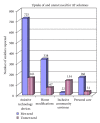Barriers and facilitators to community mobility for assistive technology users
- PMID: 23029617
- PMCID: PMC3458275
- DOI: 10.1155/2012/454195
Barriers and facilitators to community mobility for assistive technology users
Abstract
Mobility is frequently described in terms of individual body function and structures however contemporary views of disability also recognise the role of environment in creating disability. Aim. To identify consumer perspectives regarding barriers and facilitators to optimal mobility for a heterogeneous population of impaired Victorians who use assistive technology in their daily lives. Method. An accessible survey investigated the impact of supports or facilitators upon actual and desired life outcomes and health-related quality of life, from 100 AT users in Victoria, Australia. This paper reports upon data pertaining to community mobility. Results. A range of barriers and enablers to community mobility were identified including access to AT devices, environmental interventions, public transport, and inclusive community environs. Substantial levels of unmet need result in limited personal mobility and community participation. Outcomes fall short of many principles enshrined in current policy and human rights frameworks. Conclusion. AT devices as well as accessible and inclusive home and community environs are essential to maximizing mobility for many. Given the impact of the environment upon the capacity of individuals to realise community mobility, this raises the question as to whether rehabilitation practitioners, as well as prescribing AT devices, should work to build accessible communities via systemic advocacy.
Figures
References
-
- Lutz BJ, Bowers BJ. Disability in everyday life. Qualitative Health Research. 2005;15(8):1037–1054. - PubMed
-
- Oxford Dictionary of English. 2nd edition. New York, NY, USA: Oxford University Press; 2008.
-
- Rust KL, Smith RO. Assistive technology in the measurement of rehabilitation and health outcomes: a review and analysis of instruments. American Journal of Physical Medicine and Rehabilitation. 2005;84(10):780–793. - PubMed
-
- Oldridge NB. Outcomes measurement: health-related quality of life. Assistive Technology. 1996;8(2):82–93. - PubMed
-
- Hawthorne G, Richardson J, Osborne R. The Assessment of Quality of Life (AQoL) instrument: a psychometric measure of health-related quality of life. Quality of Life Research. 1999;8(3):209–224. - PubMed
LinkOut - more resources
Full Text Sources


